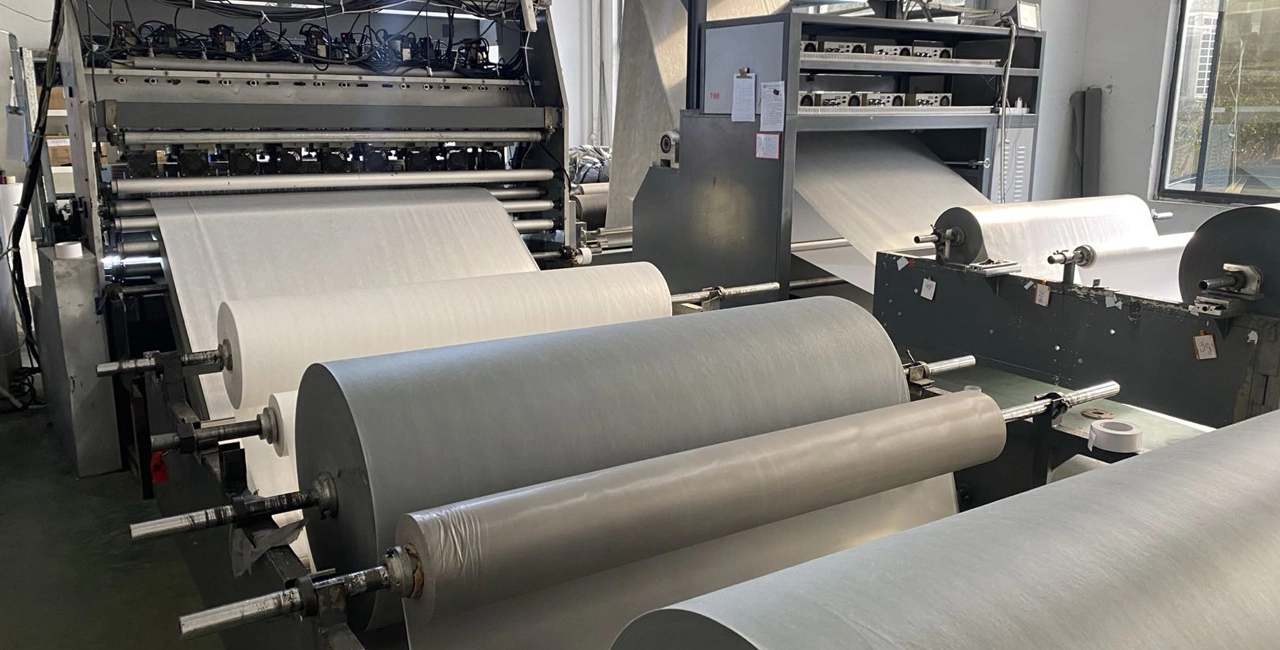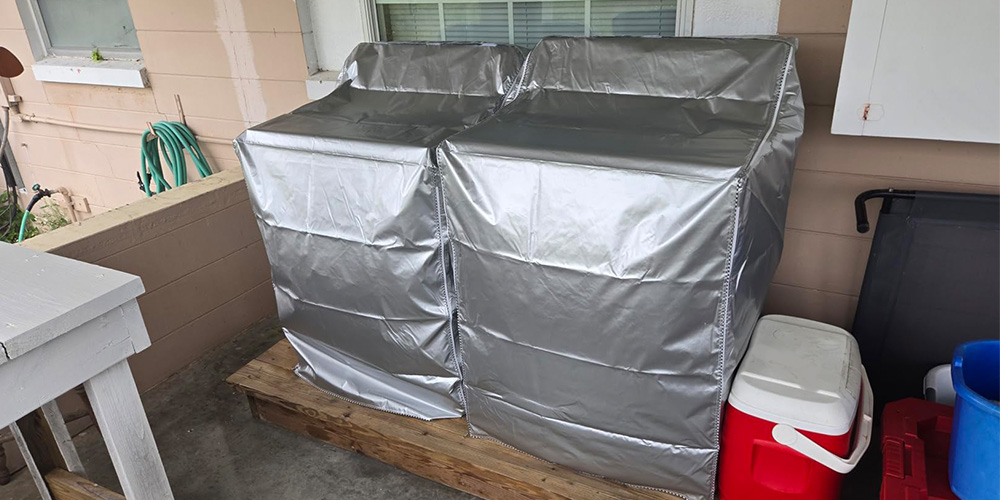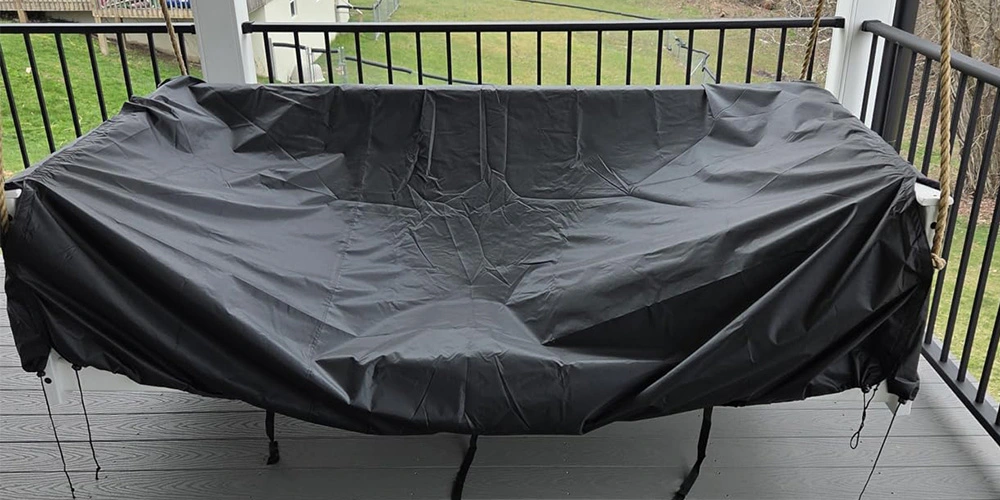This article provides a comprehensive overview of the lamination techniques used to combine Oxford cloth with different composite materials, along with an analysis of their performance differences and application recommendations.
1. Composite Lamination Techniques
Various lamination techniques are employed to integrate Oxford cloth with composite layers. The primary methods include:
Hot Press Lamination:
In this process, high temperature and pressure (typically 120–180°C) are applied to bond a composite layer—such as TPU, PVC, or EVA—with Oxford cloth. This ensures a uniform adhesion that enhances waterproof and abrasion-resistant properties.
Hot Melt Lamination:
Suitable for films like TPU and EVA, this technique involves melting the film under high temperature and pressing it onto the Oxford cloth. It requires no additional adhesive, making it environmentally friendly and resistant to peeling.
PUR Hot Melt Adhesive Lamination:
This method uses polyurethane reactive hot melt adhesive (PUR) to bond materials at relatively low temperatures (90–130°C). Once cured, the PUR adhesive provides exceptional waterproofing and weather resistance. It is ideal for combining Oxford cloth with TPU, PTFE, spunlace cotton, or needle-punched cotton, forming a high-strength bond with excellent elasticity and resistance to hydrolysis and temperature extremes.
Adhesive Lamination:
Utilizing either water-based or solvent-based adhesives, this technique bonds multiple material layers through a roll-press process. When solvent-based adhesives are used, organic solvents dissolve the adhesive to secure the film to the cloth, offering strong adhesion though with lower environmental friendliness.
Extrusion Coating:
Through melt-extrusion technology, plastics such as PE (polyethylene) or PP (polypropylene) are directly coated onto the surface of Oxford cloth, creating a waterproof layer.
Film Lamination:
In this process, thin films of TPU, PVC, EVA, or PTFE are attached to the surface of Oxford cloth using either heat press or adhesive methods. This enhances the fabric’s waterproof, windproof, and chemical resistance properties.
Dot Coating Lamination:
This method applies adhesives in a dot pattern onto the Oxford cloth surface, and then bonds the composite material using a dot-press technique. The process maintains the fabric’s inherent softness and breathability.
Knife Coating:
A knife coating technique is used to uniformly apply layers of PU, PVC, or TPU onto Oxford cloth, thereby enhancing its waterproofness and abrasion resistance.
Flame Lamination:
Suitable for needle-punched cotton and EVA foam materials, this method employs a controlled flame to carbonize the surface of the composite material, ensuring a strong bond with the fabric. It is typically used in products with high durability requirements, such as automotive seat covers and luggage.
2. Performance Differences Among Composite Materials
Different composite materials offer varying performance characteristics when combined with Oxford cloth. Key materials include:
TPU (Thermoplastic Polyurethane) Films:
Exhibiting softness, abrasion resistance, cold resistance, and environmental friendliness, TPU films also provide excellent waterproof breathability. They are well-suited for high-end outdoor apparel, technical jackets, and medical protective clothing.
PVC (Polyvinyl Chloride) Films:
Known for their waterproof and abrasion-resistant properties, PVC films are cost-effective though their breathability is poor. They are commonly used in industrial waterproof fabrics, luggage, and raincoats.
PE (Polyethylene) Films:
PE films are lightweight, waterproof, and chemically resistant but non-breathable, making them ideal for disposable protective clothing and waterproof bags.
EVA (Ethylene-Vinyl Acetate):
EVA films provide good flexibility, softness, and non-toxicity, which are beneficial for products such as waterproof tablecloths, outdoor mats, and protective gloves.
PTFE (Polytetrafluoroethylene) Films:
With exceptional breathability, waterproofing, oil resistance, and high-temperature tolerance, PTFE films are used in technical outerwear, high-end medical fabrics, and filtration media.
Spunlace Cotton:
This material offers excellent skin-friendliness and breathability, though it lacks inherent waterproof properties. It is typically applied in clothing linings, home textiles, and medical fabrics.
Needle-Punched Cotton:
Known for its fluffy, insulating, and sound-absorbing properties, needle-punched cotton generally exhibits moderate breathability and is used in automotive interiors, winter garments, and mattresses.
3. Detailed Performance Comparison
The table below summarizes the performance indices of various composite materials when laminated with Oxford cloth:
Performance Indicator | TPU | PVC | PE | EVA | PTFE | Spunlace Cotton | Needle-Punched Cotton |
Waterproofness | ★★★★★ | ★★★★★ | ★★★★☆ | ★★★★☆ | ★★★★★ | ★★☆☆☆ | ★★★☆☆ |
Breathability | ★★★★☆ | ★☆☆☆☆ | ★☆☆☆☆ | ★★★☆☆ | ★★★★★ | ★★★★★ | ★★☆☆☆ |
Softness | ★★★★☆ | ★★☆☆☆ | ★★★☆☆ | ★★★★★ | ★★★★☆ | ★★★★★ | ★★★☆☆ |
Abrasion Resistance | ★★★★★ | ★★★★★ | ★★★☆☆ | ★★★☆☆ | ★★★★☆ | ★★★☆☆ | ★★★☆☆ |
Cold Resistance | ★★★★★ | ★★☆☆☆ | ★★★☆☆ | ★★★★★ | ★★★★★ | ★★★☆☆ | ★★★☆☆ |
Environmental Friendliness | ★★★★★ | ★★☆☆☆ | ★★★★★ | ★★★★★ | ★★★★★ | ★★★★★ | ★★★★★ |
Aging Resistance | ★★★★☆ | ★★☆☆☆ | ★★★☆☆ | ★★★★★ | ★★★★★ | ★★★☆☆ | ★★★☆☆ |
4. Selection Recommendations
When selecting a composite material for lamination with Oxford cloth, consider the following:
For High-End Waterproof and Breathable Applications:
Opt for TPU composite Oxford fabric, ideal for technical outerwear and medical protective clothing.
Alternatively, PTFE composite Oxford fabric is recommended for high-end outdoor apparel and breathable raincoats.
For High Strength, Abrasion-Resistant Waterproof Requirements:
Choose PVC composite Oxford fabric for industrial waterproof materials and rainwear.
EVA composite Oxford fabric is also suitable for outdoor mats and protective gloves.
For Lightweight Waterproof Needs:
PE composite Oxford fabric is recommended for disposable protective garments and waterproof bags.
For Enhanced Warmth and Sound Insulation:
Composites involving spunlace cotton combined with Oxford cloth are suitable for winter clothing and home textiles.
Needle-punched cotton combined with Oxford cloth is ideal for automotive interiors and mattresses.
For outdoor covers—such as car covers, boat covers, and furniture covers—PU or PVC coatings are typically recommended; PU offers a lighter solution while PVC delivers superior abrasion and weather resistance. In markets with stringent environmental standards (such as Europe and the United States), TPU emerges as a more premium option.
5. Conclusion
In summary:
TPU and PTFE represent high-end composite membranes that offer both waterproofing and breathability, albeit at a higher cost.
PVC, PE, and EVA are more suited for waterproofing needs, with PVC being less breathable.
Spunlace and Needle-Punched Cotton are chosen primarily for their warmth, breathability, and comfort.
The choice of composite lamination technique ultimately dictates the final fabric performance and application. Manufacturers should select the most appropriate method based on the desired balance of breathability, waterproofing, softness, and durability.

 English
English 

